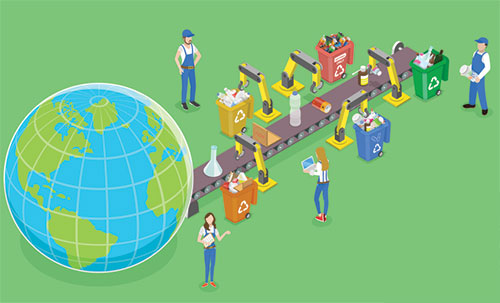May 9th, 2023
Earth Day gave us a chance to reflect on the impact we have on the environment each day. From lowering our use of natural resources to reducing overall waste, Slide strives to consistently find ways to make our processes simultaneously more efficient and eco-friendlier.
As there is historically much waste involved within the injection molding industry, one of the most beneficial ways to reduce adverse environmental impact has been by adopting technology and methods to shrink molding scrap. While practices do not necessarily produce large amounts of debris per unit, excess volumes of unwanted parts per a given cycle can accumulate quickly when not properly addressed. The scrap generally comes from the following sections of the mold:
- Sprue
- Runner
- Ejector pins
- Gate locations
- Runner system channels
If not recycled, this waste is sent to landfills where it could take hundreds of years to fully decompose. The decaying process potentially harms the planet when landfills don’t adhere to certain steps or respect the natural progression of decomposition itself. Furthermore, more energy and resources such as oil and gas are needed to keep up with mishandled surplus rubbish.
How is Scrap Typically Discharged
The most efficient way to reduce the amount of waste in the injection molding industry is through responsible recycling of scrap produced, by introducing it back into the manufacturing cycle. Post-industrial residue can be broken down and returned to the injection molding machine, or plastic pieces can be melted into pellets for reuse. Conserving recycled materials will provide a unique selling point for companies looking to differentiate themselves in our market.
Challenges of Recycling Waste
Despite the benefits involved with recycling, there are also obstacles that need to be addressed. One of the main challenges is how to best handle possible pollution of plastic discard. Salvaged scrap is often contaminated with foreign matter such as paper or metal which would reduce the quality of a product. To address this issue, molding companies should implement strict reconditioning protocols and work along with their suppliers to ensure that the highest value of recovered and repurposed plastics is always evident.
Why is it Important to Focus on Sustainable Products?
While it is not always easy, Slide believes that is it important to keep our methods as eco-friendly as possible while consistently maintaining the same level of excellence and efficiency that customers are accustomed to. As an industry, we must be dedicated to reliable conservation thus ensuring as little negative impact as possible on future generations. The paybacks that come from simple changes such as recycling are abundant. Due diligence paves the way for everything – from less waste, additional cost savings and more opportunities for product innovation.
As we move forward toward our goal of optimum sustainability, Slide will continue to learn and grow in these vital areas. We hope to keep our customer’s molding processes as proficient as possible, with minimal waste and resource depletion.
Additional reading:



